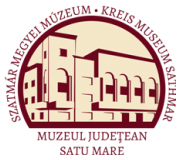Szőcs Péter Levente (szerk.): Arhitectura ecleziastică din Satu Mare (Satu Mare, 2008)
Vetiş - Vetés
Urziceni. The Roman Catholic Church “The Elevation of the Holy Cross” In the papal tithes (1332-1334), the village is still called Vada, and it also mentions the village priest: Jacob. The village was deserted during the 17th century, but it is attested to be inhabited by several Calvinist families in 1711. Sándor Károlyi colonized catholic Schwabs to replace them. The first church was consecrated in 1725, then it was extended in 1751, but it burnt together with the parish-house in 1832. The outlook of the old church can be seen on the painting dedicated to St Florian, where the burnt church is also represented: it had a semicircular sanctuary, a single nave, which was lit with semicircular windows, and a tower, with simple steeple, and three windows at the first level, which exist today. After the fire, the church was renovated, and the tower was modified in 1877 by adding another level with an octagonal plan. The clock was placed at this level. The nave was also extended in the 1930’s. The altar made in classic style is the most valuable of the interior. The upper cornice of the altar is set on four Corinthic columns and pillars, in the middle the monogram HIS, surrounded by clouds and sunrays. On the two corners, the two angels hold in their hands the tools of the suffering of Christ. The altar-painting represents The Discovery ofthe Holy Cross: the Patriarch of Jerusalem raises the retrieved cross, Empress Helena is praying, and an ill man is healed after he touches the cross. On both sides of the tabernacle, made in classic style, two apostles and two praying angels are represented. From the paintings of the edifice it is worth mentioning the painting dedicated to St Florian where, beside the patron of fire-fighters, is depicted the old church and also the participants helping extinguish the fire, wearing the specific vestments of that time. (TSz). I " I 1 I ■ I ■■ I Vetiş. Biserica reformată Hramul bisericii medievale a fost Sf Nicolae. în secolul al XIV-lea, preotul satului este menţionat în registrul de dijme papale. Biserica actuală are o singură navă, sanctuarul boltit este poligonal, sprijinit în exterior de contraforturi puternice. După Szirmay, biserica a fost construită în 1460 de către Albert Vetési, episcop de Veszprém, descendent al familiei nobiliare locale. în a doua parte a secolului al XIX-lea edificiul nu a fost tencuit. Descrierile din această perioadă menţionează că biserica este construită din piatră profilată, partea superioară a turnului are forma unei piramide cu bază octogonală şi laturile convexe, iar corola este realizată în stil renascentist târziu. Forma porţii vestice indică faptul că turnul a fost construit în ace155
